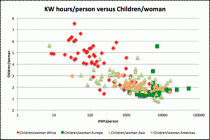By P Gosselin on 3. Juni 2012
An honest look at the data allows us to conclude only one thing: The path to protecting the planet is paved with energy and human prosperity. A shortage of either would mean big trouble for the environment.
How Much Power Should We Consume?
By Ed Caryl
There have been many suggestions here on this blog, and elsewhere, that the aim of the CAGW hoax is population control.
It is obvious that the poor people of the world produce more babies; witness Africa with a birth rate much higher than the rest of the world but a very low GDP. The Africans would seem to be the model for what the Greens want the world to be: a low carbon footprint. But with their high birth rate and low production, most of Africa teeters on the brink of famine. Unable to afford energy and sanitation, many burn forests and dump their waste untreated into the environment. This would suggest that the “low carbon footprint” model is only a recipe for disaster.
On the other hand, countries with well developed economies have low birth rates but high carbon footprints. If we are to reach a stable population, one that can be sustained far into the future, a world-wide well developed economy will be required.
A well developed economy requires energy. Producing food, goods, keeping people warm or cool, assuring hygiene, and providing transportation for people, food, and products, require energy.
What are the relationships between population growth, energy consumption, and production? First, here’s a chart of electricity consumed versus GDP (Gross Domestic Product) per person for 202 countries. (Source for all the numbers in these charts is the CIA World Factbook.) Electrical power consumption can be considered a proxy for all energy consumption.

Figure 1: Per person GDP as a function of electricity use.
It is clear from Figure 1 that to have a well developed economy with a high GDP, energy consumption must also be high. A rough trend can be seen: each KW hour produces about $10 GDP per person. The average GDP per kilowatt-hour for all countries is $8.31. The ten highest electrical power users per person are: Iceland, Norway, Kuwait, Canada, Finland, Sweden, United Arab Emirates, Luxembourg, United States, and Australia. Oil production in Africa and the Middle East distort some of the GDP numbers.
What does a high GDP do to birth rate?

Figure 2: As per capita GDP rises, fertility rates (children per woman) fall.
In Figure 2, a fertility rate of 2 is the replacement level. Fertility rates below 2 indicate a declining population. Above 2 there is an increasing population. As you can see, most of Africa is poor and pregnant. African countries that are not poor are oil producers like Libya and Nigeria. Most European populations are in decline. The exceptions are Andorra and Gibraltar. Asian countries with thriving economies are below the replacement value. Singapore is the bottom point on fertility with a rate of 0.78 children per woman. South Korea, Taiwan, Hong Kong, and Macau are just above that number.
There is a third leg to our stool: the relationship between fertility rate and electrical power. The next chart shows that relationship.

Figure 3. The more power people consume, the less children they have.
Again, most of Africa, and some of Asia, is pregnant and powerless. It should be clear by now that there is an optimum electrical power and GDP necessary to result in a sustainable, stable population. Those numbers would appear to be about 3,000 KW hours and a GDP of about $30,000 annually per person. The total population is about seven billion. Therefore:
7 billion X 3,000 KWh = 21 trillion KWh.
21 trillion kilowatt-hours would seem to be a reasonable target. The world currently produces 19 trillion kilowatt-hours of electricity. It appears that about 10% more electrical energy, with the accompanying improvement in GDP, primarily in Africa and some parts of Asia, would go a long way toward improving the quality of life and stabilizing population in those areas.
Energy drives civilization. This fundamental should be obvious to all, but apparently has not penetrated the consciousness of Greens, Progressives, and warmist zealots. Man builds cities to concentrate people, jobs, markets, and energy use into more efficient areas. Energy allows more efficient production, including food, technology, housing, and transportation. Cities and energy encourage creativity and innovation. More energy means a higher Gross Domestic Product.

Figure 4: GDP as a function of electrical power usage, for Europe and the Americas.
Figure 4 shows a clear relationship between GDP and electrical power consumption. If less electricity is generated, the cost of electricity will go up (due to the economic law of supply and demand), less will be used, and GDP will go down. The converse is, of course, more desirable: more power and reducing the cost, will result in a higher GDP. High priced wind and solar is not the answer. Let the market decide how to generate more power efficiently.
For those that are screaming “what about carbon footprint!”, the market will very soon take care of that non-problem. We are currently passing the “peak oil” point. Fossil fuels, in the long term, will be a declining portion of our power production. Barring governmental stupidity, nuclear power will be an increasing percentage of energy production.
Due to the fact that carbon dioxide is a vital plant food, as well as a minor greenhouse gas, sometime in the not too distant future we will be developing schemes to keep the atmospheric CO2 level above 400 ppm or higher.




